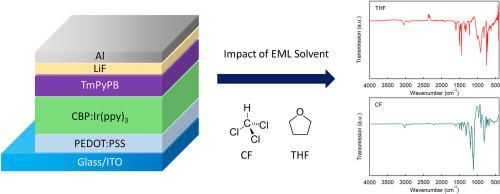Organic Electronics ( IF 2.7 ) Pub Date : 2021-07-06 , DOI: 10.1016/j.orgel.2021.106264 Jaehoon Kim 1 , Taesoo Lee 1 , Jeonghun Kwak 1 , Changhee Lee 1

|
Solution-processed organic light-emitting diode (s-OLED) is one of the strongest candidates for the next-generation display technology owing to its cost-effectiveness and broad applicability. However, its commercialization is being delayed due to the relatively low operational stability and abstruse mechanism of solvents’ influence on the device characteristics. Herein, we investigate the impact of the solvents on the characteristics of s-OLEDs by segmenting the solvents from tetrahydrofuran (THF) to chloroform (CF) and comparing them with thermally evaporated OLED as a reference device. Whereas the evaporated device offered current efficiency (CE) of 42.9 cd A−1, the THF- and CF-based ones showed 38.5 cd A−1 and 7.4 cd A−1. Besides, the CF-based device showed significantly reduced operational stability with less than 10% of that of evaporated and THF-based ones. The main reason for the deviation between the devices is interpreted to be related to the residual chemicals and degradation of the organic materials of the CF-based emissive layer (EML), which is supplemented by Fourier-transform infrared spectroscopy (FTIR) analyses. We believe that the results will provide helpful insight into developing highly efficient and stable s-OLEDs.
中文翻译:

基于傅里叶变换红外光谱分析溶剂对溶液处理有机发光二极管性能的影响
由于其成本效益和广泛的适用性,溶液处理有机发光二极管 (s-OLED) 是下一代显示技术的最强候选者之一。然而,由于相对较低的操作稳定性和溶剂对器件特性的影响机制较深奥,其商业化正在被推迟。在此,我们通过将溶剂从四氢呋喃 (THF) 划分为氯仿 (CF) 并将它们与作为参考装置的热蒸发 OLED 进行比较,来研究溶剂对 s-OLED 特性的影响。而蒸发器件提供 42.9 cd A -1 的电流效率 (CE),基于 THF 和 CF 的器件显示 38.5 cd A -1和 7.4 cd A -1. 此外,基于 CF 的设备的操作稳定性显着降低,不到蒸发和基于 THF 的设备的 10%。器件之间出现偏差的主要原因被解释为与基于 CF 的发射层 (EML) 的残留化学物质和有机材料的降解有关,并辅以傅里叶变换红外光谱 (FTIR) 分析。我们相信这些结果将为开发高效和稳定的 s-OLED 提供有用的见解。











































 京公网安备 11010802027423号
京公网安备 11010802027423号